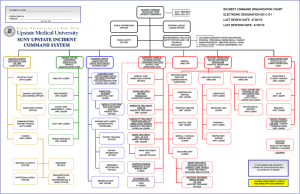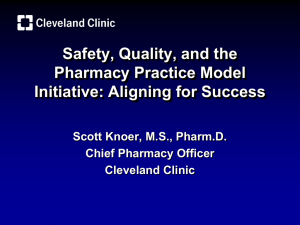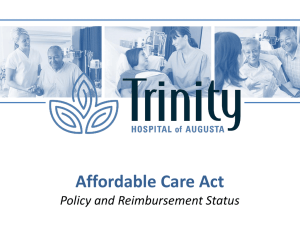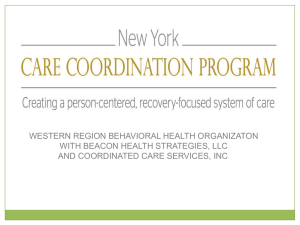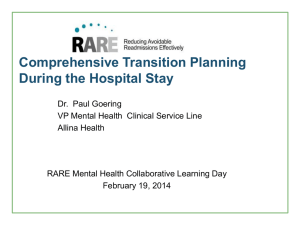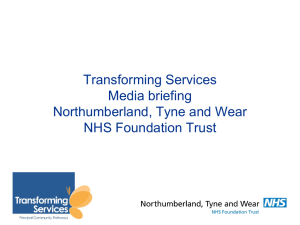Slides - RARE Campaign
advertisement
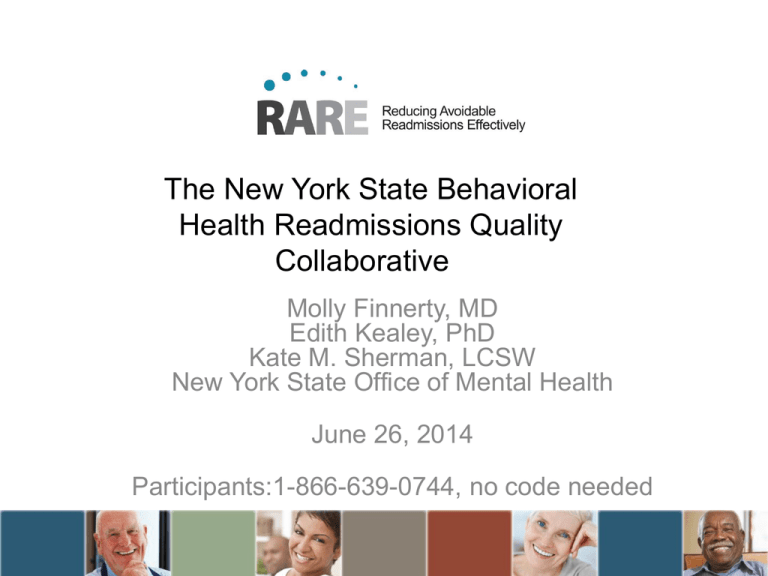
The New York State Behavioral Health Readmissions Quality Collaborative Molly Finnerty, MD Edith Kealey, PhD Kate M. Sherman, LCSW New York State Office of Mental Health June 26, 2014 Participants:1-866-639-0744, no code needed Minnesota RARE Campaign Monthly Call, June 26, 2014 The New York State Behavioral Health Readmissions Quality Collaborative Molly Finnerty, MD Edith Kealey, PhD Kate M. Sherman, LCSW New York State Office of Mental Health Outline Overview of the Project Participants and activities Project metrics and data Lessons Learned and Recommendations Interventions Emergency Department Inpatient Aftercare Managing the Project Future Plans Collaborative Participants, Activities and Time Line Readmissions Collaborative Project Context and Focus Statewide behavioral health systems transformation Previous successful learning collaborative to reduce use of antipsychotics with higher risk for metabolic disturbance for individuals with existing metabolic conditions Focus on behavioral health readmissions (individuals discharged from behavioral health inpatient services who are readmitted to behavioral health inpatient services within 30 days of discharge) Readmissions Collaborative Sponsors and Participants Sponsors NYS Office of Mental Health The 2 major hospital associations in NYS Steering Committee Greater NY Hospital Association (NYC) Healthcare Association of NYS Sponsors plus 8 hospitals / systems Specified project focus and requirements Participants: 45 hospitals statewide Invited all hospital association members with inpatient behavioral health services Participation not required, no direct financial incentives 24% of eligible hospitals participated (some attrition) Project Options: Participation Select services to participate Select settings to participate Psychiatry and/or Substance abuse services Inpatient Outpatient Emergency departments Multiple services encouraged to participate Inpatient strongly encouraged but not required Project Options: Strategies Project focus: menu of options in 3 domains Medication strategies Outpatient engagement Increase use of Long-Acting Injectables / Clozapine Medication fill at discharge Counseling for medication adherence Referrals to ACT / case management / health homes Counseling for adherence to treatment Peer services Integrated dual diagnosis treatment Enhanced discharged planning required in Inpatient and Emergency Services (defined by hospitals) Target population defined by hospitals according to the intervention selected Collaborative Activities Conferences Kick-Off Mid-point, share successful strategies Concluding Monthly Learning Collaborative Calls Interactive, report on progress Strategies Calls: Training on specific strategies Site Visits (selected hospitals) Technical assistance Identify best practices Resources and Technical Assistance PSYCKES Application NYS Medicaid claims / encounter data Behavioral health population (4.6 million) Track performance and identify clients with quality concerns Project Website Clinical tools (e.g., Readmission Risk Assessment) Developed for the collaborative Shared by participants Identified from outside sources Time Line 6/2012 - 12/2012: Kick-off and Planning Begin monthly calls Project Planning form due 10/2012 Note: Superstorm Sandy 10/2012 1/2013 - 6/2013: Begin delivering and tracking interventions (monthly reporting), Midpoint Conference Decision to extend Collaborative through 6/2014 7/2013 - 6/2014: Site Visits (n=15) and Calls (n=3) 11/2013: Midpoint Survey 6/2014: End / Concluding Conference Project Data and Measurement Data Sources NYS Medicaid Claims/Encounter Data Hospital Self-Report PSYCKES application Data Analysis Team Reported monthly by each hospital Aggregated and distributed to hospitals monthly Surveys Prescriber Survey on LAI and Clozapine Midpoint Survey on project interventions (value, feasibility) and lessons learned Key Project Metrics Inpatient (primary indicator) Outpatient Among clients discharged from your hospital’s inpatient service (psychiatry or substance abuse) Percentage readmitted to the same service at any hospital within 30 days Among clients seen in your outpatient service who had a behavioral health hospitalization at any hospital Percentage readmitted to behavioral health inpatient at any hospital within 30 days Emergency Among clients who come to ED within 30 days of discharge from psychiatric inpatient at any hospital Percentage readmitted by your ED Readmissions within 30 Days of Discharge from Inpatient Psychiatry Length of Stay 4+ Days 25% 20% Average Annual Percent Change 6/2012 to 9/2013 15% Participating: -0.5 (ns.) Start of Project NonParticipating: -3.8 (sig.) 10% 5% Participating Observed Readmission Rate NonParticipating Observed Readmission Rate Sep-13 Aug-13 Jul-13 Jun-13 May-13 Apr-13 Mar-13 Feb-13 Jan-13 Dec-12 Oct-12 Nov-12 Sep-12 Aug-12 Jul-12 Jun-12 May-12 Apr-12 Mar-12 Feb-12 Jan-12 Dec-11 Nov-11 Oct-11 Sep-11 Aug-11 Jul-11 Jun-11 May-11 Apr-11 0% Mar-11 Includes age 18+ Excludes SUD Participating Modeled Readmission Rate NonParticipating Modeled Readmission Rate Readmissions within 30 Days of Discharge from Inpatient Psychiatry Length of Stay 4+ Days Average Annual Percent Change, 6/2012 – 9/2013 by Hospital 60 50 40 30 20 10 0 -10 -20 -30 -40 -50 Green = Significant improvement Yellow = Strong trend toward improvement Red = Significant increase Psychiatric ED visits by Individuals with a Psychiatric Inpatient Stay in the Prior 30 days, and Disposition: Aggregate data for all Participating Hospitals Baseline (June 2012) ED visits Baseline rate of Readmissions in ED Most recent (Sep 2013) ED visits Most recent rate of Readmissions in ED (N) (n) % (N) (n) % ED visits with Psychiatric Inpatient stay at any hospital in prior 30 days 824 444 54% 914 454 50% ED visits with Psychiatric Inpatient stay at the same hospital in prior 30 days 413 223 54% 473 220 47% Average Annual Percent Change AAPC 95% CI Statistically Significant Trend? (P-Value <0.05) Low High -4.2 -8.3 0.1 No -7.6 -12.9 -1.9 Yes 30-Day BH Readmissions (Any Hospital) among Mental Health Outpatients PSYCKES Indicator: 12-month look-back Average Annual Percent Change 7/1/2013 to 4/1/2014 Participating: -10.4 Project Start NonParticipating: -7.5 Both statistically significant Includes individuals of all ages Measurement Challenges: Defining Readmissions What is a hospitalization? Service types Separate psychiatry and substance abuse What is a readmission? Any length of stay? Exclude short term observation? Same service type vs. Any behavioral health vs. Any service type including medical Time frame 15 / 30 / 45 day Readmission vs. high utilization over time Measurement Challenges: Other Issues Data maturity: need to wait 6 months to see both index admission and readmission appear in claims/encounter data Observation periods: Monthly data vs. longer intervals Confounding trends and variation Seasonal fluctuations Super-storm Sandy Health Home and other systems transformation initiatives Limited baseline data Exploring alternative statistical methods Exploring other related outcome and process measures Recommendations and Lessons Learned Methods: Review of Models and Initiatives RQC: Behavioral Health Readmissions Quality Collaborative Clinic CQI: OMH Continuous Quality Improvement Initiative for Health Promotion and Care Coordination CTI: Critical Time Interventions Transitions: ACT Transitions Project RED: Project RED (Re-Engineered Discharge) STAAR: State Action on Avoidable Readmissions AHRQ: Agency for Healthcare Research and Quality (AHRQ) Reducing Medicaid Readmissions Project RARE: Reducing Avoidable Readmissions Effectively Note: all quotations are from RQC Midpoint Survey Emergency Department Prevent avoidable readmissions in ED Identify high utilizers and potential readmissions Consult/ approval by last inpatient team (they come to ED to evaluate) before determining disposition Is the client’s status the same as last discharge? Is another admission likely to be helpful? Are there safe alternatives that could be tried? Identify and contact community-based supports before disposition/admission Source(s): RQC On Admission / During Inpatient Stay Assessment Identify readmissions / high utilizers Conduct in-depth review or case conference What was the last discharge plan? How well did it work? Why were they readmitted (root causes)? What can we do differently this time? Review in treatment team meeting, cross department meetings (ER, inpatient, case workers, outpatient) “Engaging the patient in reasons why the prior discharge failed can help staff gain insight.” Source(s): STAAR, AHRQ, RQC After Hospital Care Plan Develop and use After Hospital Care Plan (e.g. Project RED format), including Clear medication instructions Follow-up appointments (arranged before discharge) Name and phone number to call with any problems Educate client and family using teach-back method throughout inpatient stay Source(s): Project RED (key intervention), STAAR, RARE Access to Medication Ensure access to medication post discharge! Verify insurance formulary for meds before initiating Obtain and verify pre-authorization for meds before discharge Fill prescriptions at discharge: patients leave with meds in hand (or are walked to the pharmacy by staff) Check Medicaid status - enroll in Medicaid if eligible “Make sure that the patient can afford the medications they are discharged on.” Source(s): RARE, RQC Involve Family / Natural Supports Support evaluation Assess family needs Provide crisis intervention Psychoeducation and skill-building “Family involvement is key to a patient's recovery.” “Family support makes a tremendous difference with patient compliance.” Source(s): RQC, CTI, STAAR, RED, RARE Bridging and “Warm Hand-offs” Face to face meeting with receiving outpatient provider during inpatient stay or immediately upon discharge. Ideally: Discharge planning meeting: outpatient provider, client, family, and inpatient team; and Individual meeting/session: outpatient provider and client Source(s): STAAR, RARE, RQC, Transitions Project, CTI Co-Occurring Mental Health and Substance Use Disorders Provide Integrated Dual Diagnosis Treatment, e.g.: Screening at intake 4-quadrant model of assessment Motivational interviewing Refer to providers of integrated treatment for aftercare Source(s): RQC, EBP for co-occurring disorders Post Discharge / Outpatient Aftercare Follow-up appointment with aftercare mental health provider within 3 days of discharge (5 at most) Use higher-intensity outpatient services for hospital diversion and hospital step-down Partial Hospitalization Program (PHP) Some clinics developing Intensive Outpatient (IOP) level of care Identification of and coordination with existing services such as ACT Source(s): RARE, RQC, Transitions Follow-Up Phone Calls Follow-up phone call to client/family Within 72 hours Clinical intervention, intensive (not just a reminder call) Use teach-back method (don’t read the med list) Ideally by staff known to client Not “discharged” until attends first outpatient appointment Follow-up phone call to provider “Follow-up phone calls are very important, to make sure that discharged patients continue to take their meds and keep their follow-up appointments.” Source(s): Project RED (key component), RARE, RQC, Transitions Follow-Up Phone Call to Client: Project RED Key Components 1. Assess clinical status 2. Review and confirm each medication 3. Review follow-up appointments 4. Assess for barriers, problem-solve, and review what to do if a problem arises 5. After call: take any needed follow-up actions / inform treatment team of any issues Short-Term Case Management Services may be provided by case manager, bridger, peer, etc. Key principles Assess client risk/needs, adjust intensity and time frame accordingly Include home visits if needed Actively follow up on non-adherence to the plan, e.g.: make another appointment if missed Source(s): CTI, RARE, RQC, Transitions Community Functioning / Support Build, practice and test self-management skills Examples: filling pill boxes, keeping appointments Skill-building at each level of care to prepare for next Refer to intensive community supports, e.g.: ACT Health Home / other care management “Very helpful to establish referral links to Health Homes for care coordination services and ACT Teams.” Source(s): RQC Outpatient Crisis Management Outpatient programs develop strategies for crisis management, e.g.: relapse prevention plans monitoring for early warning signs urgent care / walk-in appointments on call availability Educate clients (and staff) not to use the ED for urgent care Source(s): Clinic CQI Managing the Project Continuous Improvement Across All Settings No single solution Portfolio of mutually reinforcing interventions Ongoing incremental changes All relevant services within the hospital should participate and collaborate on the project “There is definitely a need for increased collaboration between the inpatient and outpatient staff. Though we are one agency, and consider ourselves seamless, reviewing our internal referral process has demonstrated a disconnect in identifying and following up with patients deemed high-risk for readmission.” Source(s): RED, STAAR, RARE, RQC, Transition Data-Driven Decision Making: Project Level and Client Level Start with a root cause analysis of a sample of readmissions, including: client/caregiver interviews quantitative analysis input from hospital staff and other providers Track interventions and outcomes over time “Reducing behavioral health re-hospitalizations requires developing a system for close monitoring and tracking of patients identified as at-risk for re-hospitalization.” Source(s): RED, STAAR, AHRQ, RQC Collaboration across the Continuum of Care Know and engage your community partners Standardize communication Develop protocols for expedited referrals Collaboration on treatment and discharge planning Must include: BH, medical, housing Develop a relationship with at least one pharmacy Improved, real-time communication between inpatient and outpatient behavioral health providers and primary care physician Source(s):STAAR, AHRQ, RQC, RED, RARE Importance of Leadership Buy-in / Motivation Education Resource Allocation “Behavioral health re-admissions can be reduced when providers use the proper, evidence-based treatments for serious mental health problems….” “When administration plans a project without staff buy-in or support, it is doomed to be less successful than if staff had themselves designed the interventions/strategies. Any future collaborative project needs to incorporate more representation from front line staff.” Future Plans: Readmissions Collaborative Phase II Expanded Focus Discharge from behavioral health inpatient Psychiatry Substance abuse Readmission to any inpatient service within 30 days Psychiatry Substance abuse Medical Project Structure and Strategies All behavioral health services in the hospital participate and work collaboratively Focus on processes and care transitions Timeline: Summer 2014: Planning with Steering Committee Fall 2014: Learning Collaborative Kick-Off Question and Answer Upcoming RARE Events…. Stay tuned for the next RARE Mental Health Webinar: July 23, 2014 (12-1pm) Care transitions for the homeless Minnesota Department of Human Services Future webinars… To suggest future topics for this series, MH - Reducing Avoidable Readmissions Effectively “RARE” Networking Webinars, contact: Kathy Cummings, kcummings@icsi.org Jill Kemper, jkemper@icsi.org
